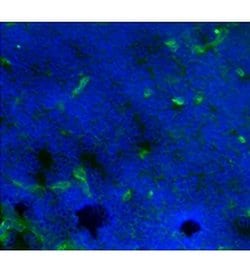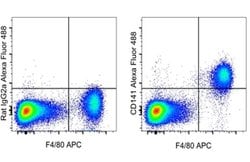Learn More
Invitrogen™ CD141 Monoclonal Antibody (LS17-9), Alexa Fluor™ 488, eBioscience™
Rat Monoclonal Antibody
Brand: Invitrogen™ 53-1411-82
Description
Description: The monoclonal antibody LS17-9 recognizes mouse CD141 (Thrombomodulin, BDCA-3), a type I cell surface glycoprotein that binds to and allosterically activates thrombin. This complex cleaves protein C and the Thrombin Activatable Fibrinolysis Inhibitor (TAFI), initiating an important anticoagulant and antifibrinolytic pathway. Although expressed across many tissues and cell types, its highest expression has been reported on the lumenal surface of vascular endothelial cell. In the immune system the highest expression can be observed on monocytes and macrophages. Soluble CD141 is constitutively present in the serum at a very low level, and can be upregulated during inflammation. The anti-inflammatory activity of CD141 results from its ability to block the highly pro-inflammatory activity of thrombin. CD141 prevents chemotaxis and binding of granulocytes to activated endothelium, and inhibits activation of eosinophils and mast cells thereby reducing inflammation. Although human CD141 is commonly used as a marker of cross-presenting dendritic cells, mouse CD141 does not exhibit the same expression pattern. Applications Reported: This LS17-9 antibody has been reported for use in flow cytometric analysis, immunohistochemical staining of frozen tissue sections, and immunocytochemistry. Applications Tested: This LS17-9 antibody has been tested by flow cytometric analysis of mouse resident peritoneal exudate cells. This can be used at less than or equal to 0.25 μg per...
Thrombomodulin (TM) is also known as Fetomodulin (FM), endothelial anticoagulant protein, or glycoprotein P112. Thrombomodulin contains six repeated domains homologous with epidermal growth factor (EGF) and an amino terminal domain homologous to lectin-like protein. Through its accelerated activation of protein C, synthesis of TM is one of several mechanisms important in maintaining thrombo-resistance and thus reducing clot formation on the surface of the endothelial cells. Immunohistochemical staining of formalin-fixed tissue for TM has been used for the study of a variety of vascular tumors, meningiomas and choriocarcinomas.
Specifications
| CD141 | |
| Monoclonal | |
| 0.5 mg/mL | |
| PBS with 0.09% sodium azide; pH 7.2 | |
| P15306 | |
| THBD | |
| Affinity Chromatography | |
| RUO | |
| 21824 | |
| 4°C, store in dark, DO NOT FREEZE! | |
| Liquid |
| Flow Cytometry, Immunohistochemistry (Frozen), Immunocytochemistry | |
| LS17-9 | |
| Alexa Fluor 488 | |
| THBD | |
| AHUS6; AI385582; BDCA3; BDCA-3; CD141; CD141 antigen; DC141; fetomodulin; sCD141; snoRNA MBII-339; soluble CD141; THBD; THPH12; THRM; thrombomdulin; thrombomodulin; thrombomodulin precursor; TM | |
| Rat | |
| 100 μg | |
| Primary | |
| Mouse | |
| Antibody | |
| IgG2a κ |
Your input is important to us. Please complete this form to provide feedback related to the content on this product.







